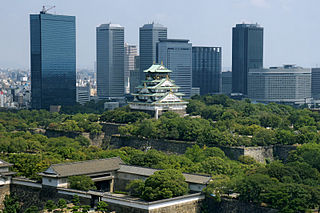
Osaka is a designated city in the Kansai region of Honshu in Japan, and one of the three major cities of Japan (Tokyo-Osaka-Nagoya). It is the capital of and most populous city in Osaka Prefecture, and the third-most populous city in Japan, following the special wards of Tokyo and Yokohama. With a population of 2.7 million in the 2020 census, it is also the largest component of the Keihanshin Metropolitan Area, which is the second-largest metropolitan area in Japan and the 10th-largest urban area in the world with more than 19 million inhabitants.
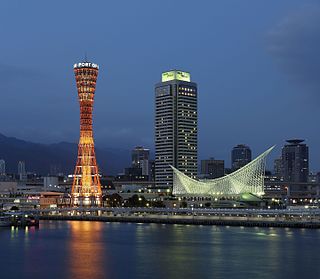
Kobe is the capital city of Hyōgo Prefecture, Japan. With a population around 1.5 million, Kobe is Japan's seventh-largest city and the third-largest port city after Tokyo and Yokohama. It is located in the Kansai region, which makes up the southern side of the main island of Honshū, on the north shore of Osaka Bay. It is part of the Keihanshin metropolitan area along with Osaka and Kyoto. The Kobe city centre is located about 35 km (22 mi) west of Osaka and 70 km (43 mi) southwest of Kyoto.

Japanese festivals are traditional festive occasions often celebrated with dance and music in Japan. Many festivals have their roots in traditional Chinese festivals, but have undergone extensive changes over time to have little resemblance to their original form, despite sharing the same name and date. There are also various local festivals that are mostly unknown outside a given prefecture.

The West Japan Railway Company, also referred to as JR West, is one of the Japan Railways Group companies and operates in western Honshu. It has its headquarters in Kita-ku, Osaka. It is listed in the Tokyo Stock Exchange, is a constituent of the TOPIX Large70 index, and is also one of only three Japan Railways Group constituents of the Nikkei 225 index: the others are JR East and JR Central. It was also listed in the Nagoya and Fukuoka stock exchanges until late 2020.

Kishiwada is a city located in Osaka Prefecture, Japan. As of 1 January 2022, the city had an estimated population of 190,853 in 88598 households and a population density of 2600 persons per km². The total area of the city is 72.72 square kilometres (28.08 sq mi). The city is well known for its Danjiri Matsuri.

Takaishi is a city located in Osaka Prefecture, Japan. As of 1 December 2021, the city had an estimated population of 55,232 and a population density of 4,888 persons per km2. The total area of the city is 11.30 square kilometres (4.36 sq mi).

Nishinomiya is a city located in Hyōgo Prefecture, Japan. As of 1 November 2022, the city had an estimated population of 484,368 in 218,948 households and a population density of 4,800 persons per km². The total area of the city is 99.98 square kilometres (38.60 sq mi). Nishinomiya is an important commercial and shipping city in the Kansai region with the third largest population in Hyōgo Prefecture. Nishinomiya is best known as the home of Kōshien Stadium, where the Hanshin Tigers baseball team plays home games and where Japan's annual high school baseball championship is held.
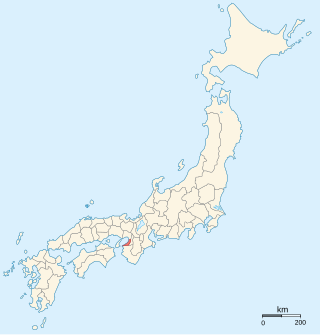
Izumi Province was a province of Japan in the area of southern Osaka Prefecture. It bordered on Kii to the south, Yamato and Kawachi to the east, and Settsu to the north. Its abbreviated form name was Senshū (泉州). In terms of the Gokishichidō system, Izumi was one of the provinces of the Kinai circuit. Under the Engishiki classification system, Izumi was ranked as one of the "inferior countries" (下国) in terms of importance. The provincial capital was located in the Fuchi neighborhood of what is now the city of Izumi. The ichinomiya of the province is the Ōtori taisha also located in Sakai.

Keihanshin is a metropolitan region in the Kansai region of Japan encompassing the metropolitan areas of the cities of Kyoto in Kyoto Prefecture, Osaka in Osaka Prefecture and Kobe in Hyōgo Prefecture. The entire region has a population of 19,302,746 over an area of 13,228 km2 (5,107 sq mi). It is the second-most-populated urban region in Japan, containing approximately 15% of Japan's population.
Kakegoe (掛け声) usually refers to shouts and calls used in performances of traditional Japanese music, Kabuki theatre, and in martial arts such as kendo.

The Kishiwada Danjiri Matsuri (岸和田だんじり祭), held in Kishiwada, Osaka, is one of the most famous Danjiri Matsuri festivals in Japan. The festival is a parade involving large wooden shrine floats that are pulled at a high speed by a large team of men.
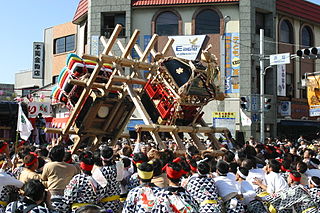
The Imari Ton-Ten-Ton Festival is a fighting festival held every year in the city of Imari, Saga Prefecture, Japan. Beginning at the Imari Shrine, the festival is well known as one of the three great fighting festivals of Japan. The festival has been held since 1829. Two shrines, Aramikoshi and Danjiri, meet at various points throughout central Imari. They are smashed together simultaneously until one shrine falls back. This is done to the sound of a beating drum within the shrine Danjiri, the sound of which gives Ton Ten Ton its name.
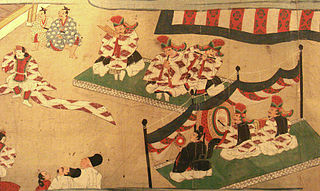
Traditional Japanese music is the folk or traditional music of Japan. Japan's Ministry of Education classifies hōgaku as a category separate from other traditional forms of music, such as gagaku or shōmyō, but most ethnomusicologists view hōgaku, in a broad sense, as the form from which the others were derived. Outside of ethnomusicology, however, hōgaku usually refers to Japanese music from around the 17th to the mid-19th century. Within this framework, there are three types of traditional music in Japan: theatrical, court music, and instrumental.

Kishiwada Domain was a feudal domain under the Tokugawa shogunate of Edo period Japan, located in Izumi Province in what is now the southern portion of modern-day Osaka Prefecture. It was centered around Kishiwada Castle and was controlled by the fudai daimyō Okabe clan throughout much of its history.

Tokyo holds many festivals (matsuri) throughout the year. Major Shinto shrine festivals include the Sanno Festival at Hie Shrine, and the Sanja Festival at Asakusa Shrine. The Kanda Matsuri in Tokyo is held every two years in May. The festival features a parade with elaborately decorated floats and thousands of people.
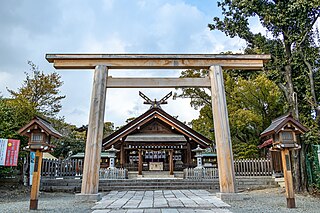
Ōtori Shrine is a Shinto shrine located in Nishi-ku, Sakai, Osaka Prefecture, Japan. It is the ichinomiya of former Izumi Province. The shrine's main festival is held annually on August 13.
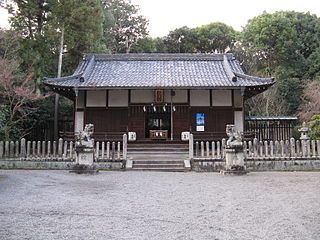
Nagao Shrine is a Shinto shrine dedicated to the goddesses Amaterasu-ōmikami, Toyouke-ōmikami, Mihikahime-mikoto and Shirakumowake-mikoto. It is located in the city of Katsuragi in Nara Prefecture, Japan.
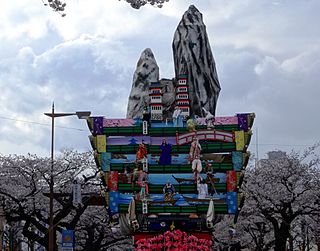
The Hitachi Furyumono (日立風流物) is a parade in Hitachi city, Japan. It is held during Hitachi Sakura Matsuri (日立さくらまつり), the annual cherry blossom festival in April, and the Great Festival at the local Kamine Shrine once in every seven years in May. It is inscribed on the UNESCO Intangible Cultural Heritage Lists as a part of "Yama, Hoko, Yatai, float festivals in Japan", 33 traditional Japan festivals.


























